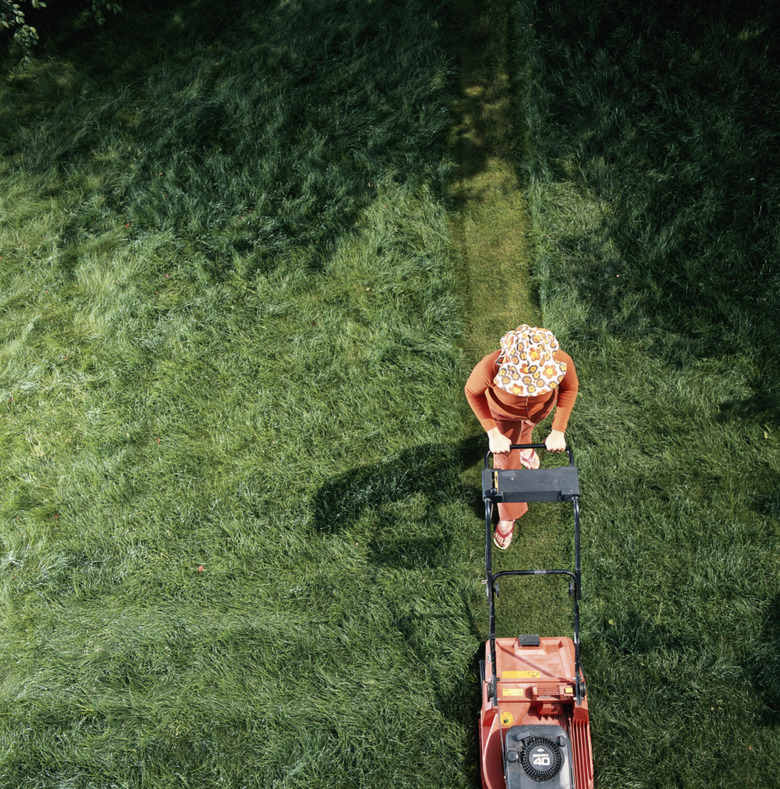What Is Torque On A Lawnmower?
When it is time to purchase a lawnmower to maintain your yard, don't get hung up on the mechanical jargon. The size of the engine and the amount of torque or horsepower the machine is rated for determines the amount of power you have and the capability of the machine to mow even the toughest yards. Understanding the type of power you need to mow your grass allows you to make an informed decision for your budget and family. It also allows you to walk confidently into your lawn and garden supply store and choose the right machine for the job at hand.
Understanding Torque
Step 1
As you cut your grass, the blades of your lawnmower twist and rotate. The amount of power available to twist the blades is known as torque. Torque is the amount of force or power driving the rotation of the blades. When purchasing a walk-behind lawnmower, it is one of the main things you want to consider, as it is your source of power. Some lawn-mowing jobs require more torque than others. The right amount of torque ensures that you have the power to complete the job at hand and improves the durability and lifespan of your machine.
- When it is time to purchase a lawnmower to maintain your yard, don't get hung up on the mechanical jargon.
- Understanding the type of power you need to mow your grass allows you to make an informed decision for your budget and family.
Torque vs. Horsepower
Step 1
Horsepower determines the amount of power you have to mow your lawn, but this is a term that is associated with riding lawnmowers as opposed to walk-behind mowers. However, like torque, more horsepower means more force and power to mow your grass. Torque and horsepower are also rated differently. For example, the gross torque on a walk-behind lawnmower is generally between 4.50 and 8.75 ft-lbs. Ft-lbs refers to the amount of force it takes to move 1 pound a distance of 1 foot. On the other hand, a riding lawnmower generally has 10.5 to 26.0 gross horsepower. It is measured differently because the transmission, hydraulics, wheels and blades are all working together to generate power to move a small, tractor-like machine.
- Horsepower determines the amount of power you have to mow your lawn, but this is a term that is associated with riding lawnmowers as opposed to walk-behind mowers.
Engine Power
Step 1
In the case of a walk-behind lawnmower, the size of the engine, along with its torque capabilities, lets you know what kinds of mowing tasks your lawnmower is up for. More torque increases effectiveness for tough jobs and ensures that you obtain a clean and even cut. The engine is responsible for generating the torque power on a lawn mower; therefore, a larger engine means more torque. For tough jobs, such as high, thick grass or hilly terrains, using a walk-behind mower with too little torque means that your machine is likely to wear out faster and require repair or replacement. These types of mowing require more torque to get the job done.
Determining Your Needs
Step 1
When deciding how much torque you need to mow your yard, it is important to consider everything from the size of your yard to the height and thickness of your grass. Small, flat yards with regularly-maintained grass require only a light duty machine, with 4.50 to 5.50 ft-lbs of torque, while large yards with tall, thick grass require a medium- to heavy-duty mower. Medium-duty walk behind mowers have between 6.25 and 6.75 ft-lbs of torque, while a heavy-duty machine has 7.00 to 8.75 ft-lbs of torque. If your yard is filled with steep hills, a heavy-duty, walk-behind mower has the torque you need to accomplish the task.
- In the case of a walk-behind lawnmower, the size of the engine, along with its torque capabilities, lets you know what kinds of mowing tasks your lawnmower is up for.
- For tough jobs, such as high, thick grass or hilly terrains, using a walk-behind mower with too little torque means that your machine is likely to wear out faster and require repair or replacement.
